Mon-El, Vidal and Dworn all had reprints in the 80 Page Giant SUPERBOY No. 129/G-22 (May ’66).
In the days when Jack Schiff and Mort Weisinger were Super-editors, it was assumed that the readership turned over quite often. Stories could be rehashed, because what reader would remember the earlier version or have the original comic book still hanging around?
We might laugh at this assumption. But the truth of it is all too real--as it's very hard to find a lot of these adventures. Some were reprinted in Giants and have since had other reprints. But often only a select few keep getting reprinted--therefore, to find these stories, you have to get the back issues. And that gets expensive.
Results 31 to 45 of 1324
-
05-13-2016, 06:31 PM #31Retired

- Join Date
- Apr 2014
- Posts
- 18,747

-
05-13-2016, 06:42 PM #32
-
05-13-2016, 07:01 PM #33Retired

- Join Date
- Apr 2014
- Posts
- 18,747

For regular size comics, if I'm desperate to have 'em and I can't afford the better grade, I'll buy the lower grade copies. But for Giants--I know that all the Giants I bought new fell apart, lost their covers and lost inside pages from the front and back of the book and sometimes pages from in the middle. And I know that if I buy a lower grade copy through the mail, what will arrive will be a pretty poor thing that I'll have a tough time keeping together in one piece. So if I can possibly afford it, I try to get a higher grade copy--because it will really be a lower grade in reality. And if I can't afford it, then I usually just wait in hope of one day getting it at a better price. However, finding any Giant that's in NM or VF is impossible, it's a unicorn--if someone is offering such a comic (other than something that's been slabbed), then I know it's a lie.
-
05-14-2016, 08:12 AM #34Retired

- Join Date
- Apr 2014
- Posts
- 18,747
 The Interplanetary Olympics
The Interplanetary Olympics

Speaking of Dworn, the Super-Weakling, Superman was a Super-Weakling when he was summoned to Thon, to compete in “The Interplanetary Olympics” in ACTION COMICS No. 220 (September ’56)--in a story with Al Plastino art, possibly written by Edmond Hamilton.

Superman is bested by Bronno of Kor; however, it turns out that Bronno is a robot, and a piece of Kryptonite inside the robot has been weakening the Man of Tomorrow. Bronno having been disqualified, the prize of the power crystal goes to the second place finisher, Sharn of Iwo--who looks like Aquaman’s cousin. Good thing, as the planet Iwo could sure use that power crystal.
This story was rehashed, with a few differences, in ACTION COMICS No. 304 (September ’63)--again titled “The Interplanetary Olympics”--this time from Leo Dorfman, Curt Swan and George Klein. All the other competitors in that one were alien bad guys intent on siphoning Superman’s powers for their own ends. The worst of them was Borko of Gor.
This version was reprinted in a Super-Spectacular issue of SUPERMAN--No. 284 (February ’75). At the time I first read that comic, my nemesis in high school gym class was a kid named Borko, who always wore an Adidas track suit and thought he was a better athlete than anyone else. So I could identify with the Man of Steel wanting to put Borko in his place.

Last edited by Jim Kelly; 05-03-2020 at 04:30 PM.
-
05-14-2016, 09:28 PM #35Retired

- Join Date
- Apr 2014
- Posts
- 18,747

Giving it a little more thought, it occurs to me that Dworn's back story might have been re-worked to create the origin story of Element Lad. Both Dworn and Jan Arrah are the last survivors of their worlds. And Dworn’s super-science that transmutates substances into gold makes him the target of gangsters, just as Element Lad’s power to transmutate different elements makes him the target of interplanetary pirates.
-
05-14-2016, 09:43 PM #36Retired

- Join Date
- Apr 2014
- Posts
- 18,747
 No Mercy for a Hero
No Mercy for a Hero
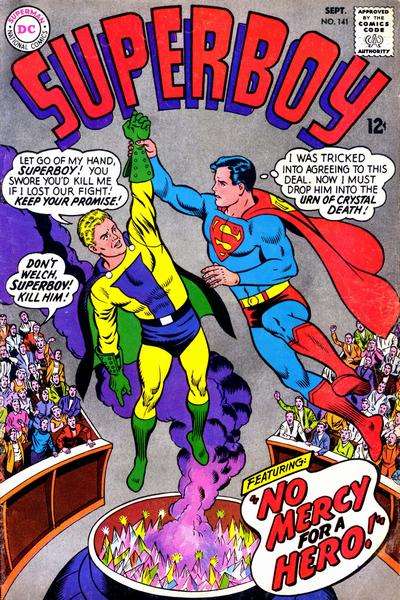
By the galaxies of Grann, SUPERBOY No. 141 (September ’67) told one hell of a story. When I brought this mag home from Ryan’s Drugstore, I was gripped by the harrowing full-issue story called “No Mercy for a Hero” and couldn’t put it down until I got to the end. Leo Dorfman sure put our Boy of Steel through his paces. And George Papp’s usual strong illustrations had an even greater vibrancy thanks to Chic Stone’s bold inking style. What a nerve-racking adventure--I think it gave me grey hairs.
When a new student, Ron Avnet, always bullies the weaker kids in Smallville--well, it turns out he’s actually Ron-Avon of Belgor, an aggressor world where even the children are taught to love war.
Equipped with power gauntlets and other super-science, the Belgorian Belligerent blackmails the Boy of Steel into battle by threatening to use his gauntlets to turn everyone on Earth to lifeless metal. Two of their matches play out on Earth--with both combatants at a 1-1 draw--then the contest moves to Belgor--a world so far away that it would take even Superboy a week to reach there. But the space warp drive in Ron-Avon’s rocket ship accomplishes the journey in mere moments.
However, on Belgor, the tough-talking bully shows another side to his personality, when Ron-Avon starts to tremble with fright in the presence of the Guardians--the rulers who enforce the laws on Belgor. Superboy witnesses one political prisoner put inside a rocketship by the Guardians, then launched into the upper atmosphere, where the rocket explodes--an official Belgorian execution.

Belgor has no moon nor sun--it must not exist in a solar system. Superboy loses some but not all of his powers on this world and is able to defeat Ron-Avon in another contest. The explanation he gives provides some useful insight into how the Caped Kryptonian’s powers work: “I need the rays of a yellow sun or I have no invulnerability and super senses . . . and I lose some of my flying ability! But Belgor has lighter gravity than my home world, Krypton, so I retained my muscular powers!”
Having lost to Superboy, Ron-Avon begs the Boy of Steel to kill him, as even the family of a defeated warrior is thought unworthy to live. The Guardians threaten to execute Ron-Avon’s parents in one of their death rockets, unless Superboy drops his defeated opponent in the Urn of Crystal Death. The Boy of Steel pretends to do so, but in fact his victim, wrapped in the super cape, escapes death. And so the two champions combine forces to overthrow the tyrant Guardians. Belgor is returned to the peace-loving world it once was before the Guardians siezed power and Superboy is honoured as a saviour by the grateful Belgorians.
I wonder if, in fact, the fighting foes of Gor, Kor and Belgor--Borko, Bronno and Ron-Avon--don’t all originate from the same region of space, if not the same world.Last edited by Jim Kelly; 05-03-2020 at 08:01 PM.
-
05-15-2016, 12:34 PM #37Retired

- Join Date
- Apr 2014
- Posts
- 18,747
 Batman--the Superman of Planet X
Batman--the Superman of Planet X
Bruce Wayne is “Batman--the Superman of Planet X,” in BATMAN No. 113 (February ’58)--by France Herron, Dick Sprang and Charles Paris.

With the synchronicity of a dream, Batman is teleported to the planet Zur-En-Arrh, in a star system far from Earth. There, he is greeted by Tlano, the Batman of that world, who has modelled himself after the Masked Manhunter, using futuristic technology, including the powers of his Bat-Radia, to battle crime.
As a result of Zur-En-Arrh’s differences from Earth, there Batman has the abilities of a Superman.
It would be far easier to consider this a dream--as so many other tales of Super-Men turn out to be in the end--yet how can it be, when in his hand Batman holds the Bat-Radia?Last edited by Jim Kelly; 05-03-2020 at 08:23 PM.
-
05-15-2016, 08:06 PM #38Retired

- Join Date
- Apr 2014
- Posts
- 18,747
 The Super Family from Outer Space
The Super Family from Outer Space
“The Super Family from Outer Space” arrives on Earth in the March SUPERMAN issue for 1956 (No. 104), illustrated by Wayne Boring and Stan Kaye (the writer is undetermined).
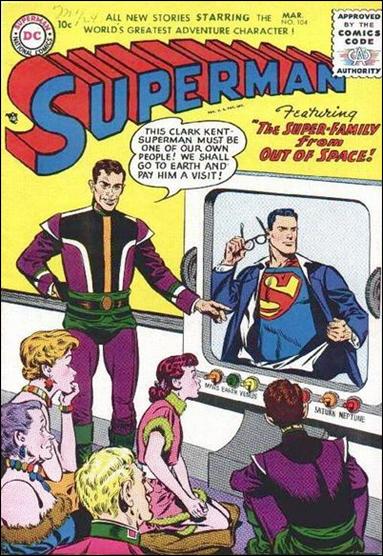
Having come from the scientifically advanced planet of Skar, Vitor Vall is the only one identified by name; however, the rest of the Vall family would seem to be his wife, their young son and daughter, and Vitor’s elderly parents. On Earth, with its lesser gravity, they have super-powers, but they are limited by the air which is thinner than on their homeworld. They arrive on this planet, in search of a lost cousin, believing Clark to be him.

When they discover their mistake, the Super Family decide to stay for awhile and play the part of cousins to the orphaned Superman. They’re a lively and rambunctious bunch and all too eager to help.

Superman doesn’t seem to fully appreciate the benefit of having a loving family--worried too much about protecting his secret identity (the poor Man of Steel can never see the forest for the trees, despite his amazing eyesight). And hoping to send them packing, he builds the world’s greatest telescope, with which he locates the Valls' lost cousin, in a dark nebula. And so Clark’s space cousins depart, leaving the Last Son of Krypton alone again--just how he likes it.Last edited by Jim Kelly; 05-05-2020 at 04:28 PM.
-
05-15-2016, 08:21 PM #39Retired

- Join Date
- Apr 2014
- Posts
- 18,747
 The Mysterious Mighty Mite
The Mysterious Mighty Mite
Little brats were often featured in DC’s super-hero comics, back in the ‘60s. And I’m sure this was because their presecnce in a comic book could drive up sales. I know seeing a cute kid on the cover of a comic book could get my sister and I to buy that comic if we saw it in Mrs. Ryan’s drugstore.
After all, we loved to read comics like LITTLE ARCHIE, SUGAR AND SPIKE and RICHIE RICH, so why shouldn’t we gravitate toward the same material in a super-hero comic?
Which is most probably why I grabbed SUPERBOY No. 137 (April ’67), with its Swan and Klein cover showing a charming toddler holding the Boy of Steel over his head.
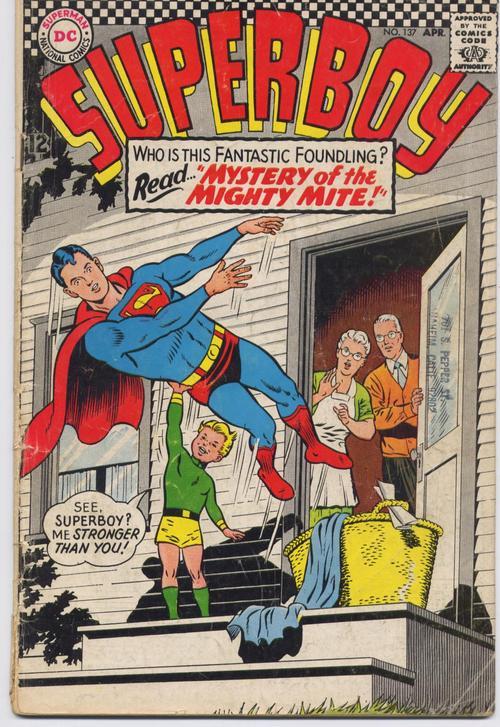
“The Mysterious Mighty Mite” by Leo Dorfman, George Papp and Chic Stone--the story behind that cover--is not what it seems.
Clark finds a baby on the Kent doorstep, with a note written in Kryptonese that says the Kryptonian toddler is Kit-El and cautions that he should not be given milk. Clark thinks it’s all a hoax--Krypton blew up 12 years ago--and when the baby pulls a tantrum he tells his mother to give Kit-El some milk, despite the warning in the note.
Clark imagines the baby being raised by the Kents and the problems that will make for him . . .

Later on, Superboy returns to the Kent house to find that Kit-El is now a teen--the effect of the milk!

To be concluded in post #53Last edited by Jim Kelly; 10-05-2021 at 03:49 PM.
-
05-15-2016, 08:28 PM #40Retired

- Join Date
- Apr 2014
- Posts
- 18,747
 Superboy’s Lost Identity
Superboy’s Lost Identity
To quote Clark Kent, from “Superboy’s Lost Identity” by Otto Binder, George Papp and Chic Stone--in SUPERBOY No. 144 (January ’68)--“this deal smells like a plot to me.”
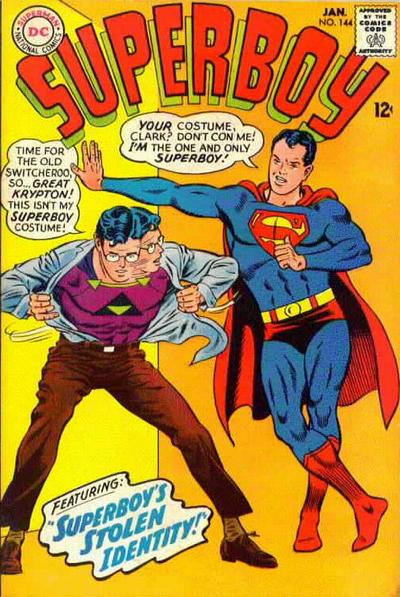
The ‘60s were a really confusing time for everyone--and this confusion appears in both high art and low art. People collectively seemed to be going through some kind of psychological trauma with no easy solution. That might explain why the Weisinger era comics were so full of complicated plots that turned everything inside out, so you were left not knowing what was real anymore.
I won’t even try to sum up all the weird contortions of logic that Superboy must endure before he finally gets relief--when everything is explained. And maybe that relief is the point--the vicarious thrill that everybody needed and couldn’t get in real life. Maybe going through this David Lynch trauma was just so we could feel better once it all stopped.
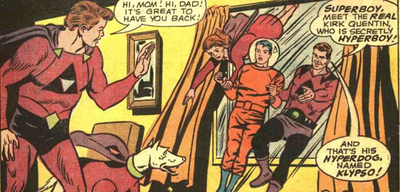
In the end, after playing the part of an ersatz Hyperboy on Earth, Superboy is taken to the planet Trombus, by Mom and Dad Quentin, where he meets the real Hyperboy--their son Kirk--and his Hyperdog, Klypso. The Hyper-Family escaped their doomed planet in a rocket ship and under Trombus’ red sun they have super-powers. Kirk’s younger brain made him more super than his parents, so he’s the leader of the Hyper-Family.
-
05-16-2016, 09:06 PM #41Retired

- Join Date
- Apr 2014
- Posts
- 18,747

The costume designs that the classic artists had to come up with for the other world Super-Men are fascinating variations on the traditional super-hero uniform.
Where Superman's outift has the three primary colours--blue, red and yellow, with blue and red being chief--a lot of the other costumes go with secondary colours.
Hyper-Man (Chester King) mixes a violet (maroon?) with orange and green, but there are a few yellow accents. Hyperboy has violet and purple, with green and black accents--and his Hyper-Dad chooses black leggings.
Astounding Man has those shoulder pads that are popular on futuristic planets. And his colours--yellow with green--sharply contrast with Superman's.
Grown-up Kit-El's outfit is the reverse--green and yellow, also with those shoulder pads. But he also adds a cape with a high collar. The shorts have a diagonal cut--if Superman tried this look, there's no way anyone could confuse those shorts with underwear. All in all, quite the striking ensemble.
Marsboy's original costume has the look of ancient dress that goes with the Atlantean roots of his people. And again, he chooses colours that contrast with Superboy's (yellow and purple with green accents). While his later costume looks like a mix of Karate Kid and Starboy--orange and white.
The Alien Super-Boy, Logi, also chooses yellow with purple--which contrasts with his green skin.
I always thought Skyboy's harness was an interesting design feature and while his costume mostly reflects Superman's red and blue, Vitar Vall--having the same design--tries out violet and green. However, for most of the Valls' story, they dress in civilian clothes--looking like your average 1950s sitcom family.
Luma Lynai anticpates Power Girl's white outfit, but makes good use of green in her accessories.
And, but for the furry white trimming--which must be because he lives on a cold planet--Regor's Christmas coloured uniform looks a lot like Starman's. Kell Orr pulls off the reverse--green and red--when he's on Xenon; however, this is similar to standard Kryptonian dress, such as Jor-El might wear.
Power-Boy again favours the green, red and yellow. But wearing his burnoose and Arabic style headgear, his has to be the most original costume design of them all.
-
05-17-2016, 05:52 PM #42
-
05-17-2016, 06:26 PM #43Retired

- Join Date
- Apr 2014
- Posts
- 18,747

While all of the Super titles could have these weird plots, the Superboy stories felt more subversive. Not that I could articulate this sense of foreboding at the time. But I think it was the Small Town America setting--it had an eerie feeling. In this seemingly quaint town there was all kinds of twisted things going on.
I was just starting to read Ray Bradbuy (our school library had many of his books) and he often wrote weird stories that had that small town setting--and that sense of dark things happening behind closed doors. Probably an influence on Stephen King.
I also noticed, just in this rough sampling of Superboy stories, when Curt Swan is the penciller he makes lots of reference to Norman Rockwell--especially "Freedom From Want." Martha Kent is seen at the dinner table often striking the same pose as the maternal woman in that painting.

-
07-29-2016, 01:16 PM #44All-New Member

- Join Date
- Jul 2016
- Posts
- 2

I didn't notice... did anyone mention Dyno-Man of Sorrta?
-
07-29-2016, 01:17 PM #45All-New Member

- Join Date
- Jul 2016
- Posts
- 2

Yeah, I remember reading somewhere that Curt Swan called Norman Rockwell one of his biggest influences.


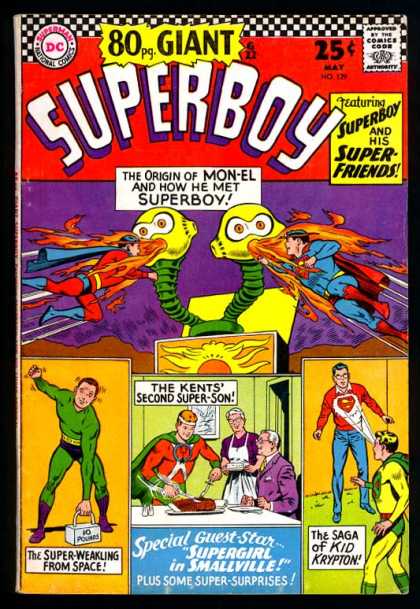

 Reply With Quote
Reply With Quote

